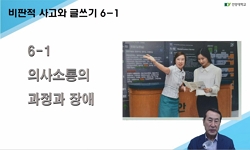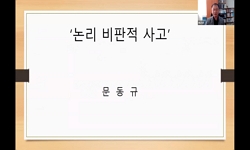This study aimed to examine the relationship between digital literacy and the characteristics of Homo Sensus that have emerged while leading the digital culture to present a university writing class model using digital literacy and analyze its effects...
http://chineseinput.net/에서 pinyin(병음)방식으로 중국어를 변환할 수 있습니다.
변환된 중국어를 복사하여 사용하시면 됩니다.
- 中文 을 입력하시려면 zhongwen을 입력하시고 space를누르시면됩니다.
- 北京 을 입력하시려면 beijing을 입력하시고 space를 누르시면 됩니다.

호모 센수스의 특성을 고려한 디지털 리터러시 활용 글쓰기 수업 모델 = A Digital Literacy Writing Class Model Considering the Characteristics of Homo Sensus
한글로보기https://www.riss.kr/link?id=A108300328
-
저자
김민옥 (부산외국어대학교)
- 발행기관
- 학술지명
- 권호사항
-
발행연도
2022
-
작성언어
Korean
-
주제어
Writing ; Digital Literacy ; Homo Sensus ; AACRA Model ; Digital Media ; Digital Literacy ; Digital Media ; Total Sense ; Critical Thinking ; 글쓰기 ; 디지털 리터러시 ; 호모 센수스 ; 디지털 리터러시 모델 ; 디지털 매체 ; 디지털 문해력 ; 디지털 매체 ; 총체적 감각 ; 비판적 사고
-
등재정보
KCI등재
-
자료형태
학술저널
- 발행기관 URL
-
수록면
401-436(36쪽)
- DOI식별코드
- 제공처
- 소장기관
-
0
상세조회 -
0
다운로드
부가정보
다국어 초록 (Multilingual Abstract)
The digital literacy model proposed by Renée Hobbs assumes that Homo Sensus as a writing subject plays the role of a new cultural group by checking the contents produced by digital media in real time using the holistic sense and producing and spreading creative content. The AACRA model was applied to present examples and effects of writing classes. The digital literacy activities of university students at each stage of AACRA consisted of viewing images or viewing and interpreting data and critically accepting them to implement a new form of creation. It was assumed that if the writing subject actively participates in expression activities in a digital literacy situation, the understanding of digital literacy and digital literacy may increase. In addition, the VALUE writing rubric was applied to increase the objectivity of the writing achievement standards for the results (public service advertisement campaign, card news, infographic, final thesis) produced by the students.
Considering the characteristics of Homo Sensus and applying the AACRA model, the effect of the digital literacy writing class enables activating holistic perceptions; accordingly, students can actively participate in the class, increase their understanding of digital literacy, and critically analyze digital media. In the process of understanding, interpreting, and accepting, digital literacy can be improved. In addition, through digital literacy and digital literacy surveys, instructors can identify the characteristics of the writing subject, Homo Sensus, and set digital literacy usage standards to structure students’ writing performance interestingly.
This study aimed to examine the relationship between digital literacy and the characteristics of Homo Sensus that have emerged while leading the digital culture to present a university writing class model using digital literacy and analyze its effects to suggest the direction of writing class.
The digital literacy model proposed by Renée Hobbs assumes that Homo Sensus as a writing subject plays the role of a new cultural group by checking the contents produced by digital media in real time using the holistic sense and producing and spreading creative content. The AACRA model was applied to present examples and effects of writing classes. The digital literacy activities of university students at each stage of AACRA consisted of viewing images or viewing and interpreting data and critically accepting them to implement a new form of creation. It was assumed that if the writing subject actively participates in expression activities in a digital literacy situation, the understanding of digital literacy and digital literacy may increase. In addition, the VALUE writing rubric was applied to increase the objectivity of the writing achievement standards for the results (public service advertisement campaign, card news, infographic, final thesis) produced by the students.
Considering the characteristics of Homo Sensus and applying the AACRA model, the effect of the digital literacy writing class enables activating holistic perceptions; accordingly, students can actively participate in the class, increase their understanding of digital literacy, and critically analyze digital media. In the process of understanding, interpreting, and accepting, digital literacy can be improved. In addition, through digital literacy and digital literacy surveys, instructors can identify the characteristics of the writing subject, Homo Sensus, and set digital literacy usage standards to structure students’ writing performance interestingly.
국문 초록 (Abstract)
글쓰기 주체로서의 호모 센수스가 총체적 감각을 활용하여 디지털 매체가 생산한 콘텐츠를 실시간으로 확인하고 창의적인 콘텐츠를 생산하여 확산시키면서 새로운 문화집단의역할을 수행하고 있음을 고려하고, 르네 홉스가 제안한 디지털 리터러시 모델(AACRA)을적용하여 글쓰기 수업의 실례와 효과를 제시하였다. AACRA 각 단계에서 대학생들의 디지털 리터러시 활동은 영상을 보거나 자료를 보고 해석하고 비판적으로 그것을 수용하여 새로운 형태의 창착물을 구현하는 형태로 구성했다. 글쓰기 주체가 디지털 리터러시 상황에서 표현 활동에 적극 참여할 경우 디지털 리터러시에 대한 이해도도 높아지고 디지털문해력도 상승할 수 있다는 점을 고려한 것이다. 아울러 학생들이 제작한 결과물(공익광고캠페인, 카드 뉴스, 인포그래픽, 기말 소논문)에 대한 글쓰기 성취 기준의 객관성을 높이기위해 VALUE 글쓰기 루브릭을 적용하였다.
호모 센수스의 특성을 고려하고 AACRA 모델을 적용한 디지털 리터러시 글쓰기 수업의 효과는 총체적인 지각을 활성화할 수 있도록 하기 때문에 학생들이 수업에 능동적으로참여하면서 디지털 리터러시에 대한 이해도를 높일 수 있고 디지털 매체를 비판적 분석하고 해석하여 수용하는 과정에서 디지털 문해력을 향상시킬 수 있다는 점이다. 아울러 교수자는 디지털 리터러시 및 디지털 문해력 조사를 통해 글쓰기 주체인 호모 센수의 특성을파악하고 디지털 리터러시 활용 기준을 설정하여 학생들의 글쓰기 수행 방식을 흥미롭게구조화할 수 있는 방안을 마련할 수 있다.
본고는 디지털 문화를 이끌며 등장한 호모 센수스의 특성과 디지털 리터러시의 관계를살피고, 디지털 리터러시를 활용한 대학 글쓰기 수업 모델을 제시한 후, 그 효과를 분석하여 글쓰기 수...
본고는 디지털 문화를 이끌며 등장한 호모 센수스의 특성과 디지털 리터러시의 관계를살피고, 디지털 리터러시를 활용한 대학 글쓰기 수업 모델을 제시한 후, 그 효과를 분석하여 글쓰기 수업의 방향을 제시하고자 하는 데 목적이 있다.
글쓰기 주체로서의 호모 센수스가 총체적 감각을 활용하여 디지털 매체가 생산한 콘텐츠를 실시간으로 확인하고 창의적인 콘텐츠를 생산하여 확산시키면서 새로운 문화집단의역할을 수행하고 있음을 고려하고, 르네 홉스가 제안한 디지털 리터러시 모델(AACRA)을적용하여 글쓰기 수업의 실례와 효과를 제시하였다. AACRA 각 단계에서 대학생들의 디지털 리터러시 활동은 영상을 보거나 자료를 보고 해석하고 비판적으로 그것을 수용하여 새로운 형태의 창착물을 구현하는 형태로 구성했다. 글쓰기 주체가 디지털 리터러시 상황에서 표현 활동에 적극 참여할 경우 디지털 리터러시에 대한 이해도도 높아지고 디지털문해력도 상승할 수 있다는 점을 고려한 것이다. 아울러 학생들이 제작한 결과물(공익광고캠페인, 카드 뉴스, 인포그래픽, 기말 소논문)에 대한 글쓰기 성취 기준의 객관성을 높이기위해 VALUE 글쓰기 루브릭을 적용하였다.
호모 센수스의 특성을 고려하고 AACRA 모델을 적용한 디지털 리터러시 글쓰기 수업의 효과는 총체적인 지각을 활성화할 수 있도록 하기 때문에 학생들이 수업에 능동적으로참여하면서 디지털 리터러시에 대한 이해도를 높일 수 있고 디지털 매체를 비판적 분석하고 해석하여 수용하는 과정에서 디지털 문해력을 향상시킬 수 있다는 점이다. 아울러 교수자는 디지털 리터러시 및 디지털 문해력 조사를 통해 글쓰기 주체인 호모 센수의 특성을파악하고 디지털 리터러시 활용 기준을 설정하여 학생들의 글쓰기 수행 방식을 흥미롭게구조화할 수 있는 방안을 마련할 수 있다.
참고문헌 (Reference)
1 이수안, "테크노 문화풍경과 호모 센수스" 북코리아 2018
2 노은희 ; 신호재 ; 이재진, "초・중학교 교사의 디지털 리터러시 교육에 대한 인식 분석" 한국교육과정평가원 22 (22): 31-60, 2019
3 김선태 ; 남영호, "초등학생의 디지털 리터러시 역량에 관한 연구" 한국정보교육학회 12 (12): 151-161, 2008
4 양길석 ; 옥현진 ; 서수현, "우리나라 초등학생과 중학생의 디지털 리터러시의 정의적 특성과 가정 변인 간의 관계" 교육연구원 40 (40): 199-222, 2020
5 마셜 맥루한, "미디어의 이해 : 인간의 확장" 커뮤니케이션북스 2011
6 김양은, "미디어 교육의 개념 변화에 대한 고찰" 한국언론정보학회 28 : 77-110, 2005
7 한국전자출판학회, "디지털인문학시대의 디지털 독서와 트랜스리터러시" 스토리하우스 2021
8 "디지털리터러시교육협회"
9 르네 홉스, "디지털‧미디어 리터러시 수업" 학이시습 2021
10 정희모, "디지털 시대 주체 회복을 위한 대학 글쓰기 교육의 필요성" 한국 리터러시 학회 (12) : 11-32, 2015
1 이수안, "테크노 문화풍경과 호모 센수스" 북코리아 2018
2 노은희 ; 신호재 ; 이재진, "초・중학교 교사의 디지털 리터러시 교육에 대한 인식 분석" 한국교육과정평가원 22 (22): 31-60, 2019
3 김선태 ; 남영호, "초등학생의 디지털 리터러시 역량에 관한 연구" 한국정보교육학회 12 (12): 151-161, 2008
4 양길석 ; 옥현진 ; 서수현, "우리나라 초등학생과 중학생의 디지털 리터러시의 정의적 특성과 가정 변인 간의 관계" 교육연구원 40 (40): 199-222, 2020
5 마셜 맥루한, "미디어의 이해 : 인간의 확장" 커뮤니케이션북스 2011
6 김양은, "미디어 교육의 개념 변화에 대한 고찰" 한국언론정보학회 28 : 77-110, 2005
7 한국전자출판학회, "디지털인문학시대의 디지털 독서와 트랜스리터러시" 스토리하우스 2021
8 "디지털리터러시교육협회"
9 르네 홉스, "디지털‧미디어 리터러시 수업" 학이시습 2021
10 정희모, "디지털 시대 주체 회복을 위한 대학 글쓰기 교육의 필요성" 한국 리터러시 학회 (12) : 11-32, 2015
11 신소영 ; 이승희, "디지털 리터러시 측정도구 개발 및 타당화 연구" 학습자중심교과교육학회 19 (19): 749-768, 2019
12 김민하 ; 안미리, "디지털 리터러시 능력 확인을 위한 문항개발 및 능력 평가" 한국교육정보미디어학회 9 (9): 159-192, 2003
13 김혜정, "디지털 리터러시 교육경험에 대한 대학생의 인식 분석" 학습자중심교과교육학회 16 (16): 937-958, 2016
14 민춘기, "디지털 글쓰기의 수업 계획 시안 및 대학생의 인식 분석" 한국교양교육학회 11 (11): 131-172, 2017
15 김민정 ; 박영민, "대학생의 디지털 리터러시 태도가 디지털 리터러시 수준에 미치는 영향 분석" 학습자중심교과교육학회 21 (21): 495-507, 2021
16 김채윤, "대학생 필자의 전공 리포트 쓰기 과정에 대한 연구" 고려대학교 교육대학원 2015
17 정희모, "글쓰기 과목의 목표 설정과 학습방안" 한국문학연구학회 17 : 181-204, 2001
18 김도헌, "국내 미디어·디지털·정보·ICT 리터러시의 연구동향 분석" 교육연구소 26 (26): 93-119, 2020
19 장서란, "교양 국어 수업에서의 미디어 리터러시 교육 필요성 연구 - 이공계 글쓰기를 중심으로" 한국 리터러시 학회 11 (11): 47-77, 2020
20 최철재 ; 강동수 ; 최진식, "K-대학교 학군사관 후보생의 디지털 리터러시 수준분석" 한국전자통신학회 13 (13): 113-118, 2018
21 Renee Hobbs, "Digital and Media Literacy : A Plan of Action" Aspen Institute and the James L. Knight Foundation 2010
동일학술지(권/호) 다른 논문
-
문학과 정치 이데올로기의 관계성 - 작가 오성덕을 중심으로 -
- 중앙어문학회
- 이동순
- 2022
- KCI등재
-
<헤어질 결심>의 다층성 연구 - 영화적 장치를 통한 의미의 보류와 생성을 중심으로 -
- 중앙어문학회
- 이다운
- 2022
- KCI등재
-
- 중앙어문학회
- 김진기
- 2022
- KCI등재
-
- 중앙어문학회
- 백승주
- 2022
- KCI등재




 DBpia
DBpia







